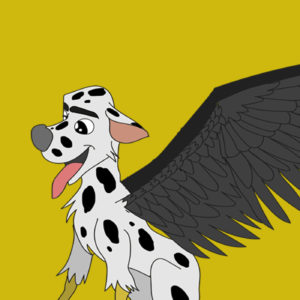Cynogriffin (say-noh-grif-in)
All creatures in the griffin family were crosses between two or more animals from Earth. Cynogriffins were winged dog/eagle hybrids. They were very loyal canines who occasionally broke free of their pack to soar through the star covered sky of Fabella. A proud animal, they resisted being trained and hated to be ridden. Cynogriffins aged at the same rate as dogs. Lifespan depended largely on their size. An average cynogriffin was about the height of a good mid-sized dog. Minus the height of the wings, their heads normally came up to the thigh of a full-grown person. When fully extended, the wingspan was approximately 2.5 meters (roughly the same as an adult Golden Eagle). Their forefeet were eagle-like talons (good for quickly snatching small prey) while their back feet were padded dog legs (aiding in a softer landing.) Their fur and feathers ranged in a variety of colors; shades of brown and grey were the most common.
Every flock of cynogriffins had at least one alpha male, approximately five females, and their puppies. The alpha male was in charge of navigating the skies as he lead the flock all over the northern hemisphere of Fabella. Females were charged with providing food to the flock. Sometimes they would leave to go in search of food for several days and even weeks. All-female pups hatched from eggs, and all-male pups were live births. Mothers laid their eggs and give birth in private. After laying her eggs, the mother would mark them with a scent letting all alpha males in the area know they were free to be accepted into a flock before leaving with her live male pups. Another alpha male cynogriffin came along and decided whether to take the female hatchlings into the flock or not. These female pups were raised to adulthood before they were sent off on their own flock with a young alpha male. It was very unusual for eggs to hatch without a flock, but it could happen. While this process was unusual, it served to develop a strong bond between all cynogriffins as each flock was trusted to raise another’s female puppies. Pups could fly immediately after birth and often followed females on their hunts. Males were allowed to mature to the age of two dog years before being forced out of the flock or killed.

